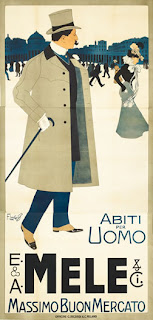Starting in 1896, the Neapolitan department store Mele became the biggest account for Ricordi, the pioneering Milan lithographer. Ricordi put its very best artist to work for the innovative retailer. Using large images, Mele brought the elegance and excitement of pre-war High Society to an eager and growing Italian bourgeois class. The posters were often reviewed in the press, and were also sold in fine art galleries.
Laskoff, one of Ricordi's greatest poster artists, produced five masterpieces for Mele between 1900 and 1904. His "Abiti per Uomo" is just one example of the remarkable caliber of his work. An elegant Neapolitan man walks in the Piazza Plebiscito, taking in the sights. It of course includes a young woman, who seems to stroll slowly enough for our protagonist to intercept her. There is no doubt that wearing his Mele Suit and topcoat he will be a great catch!












